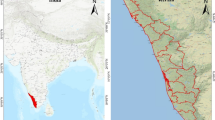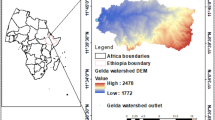Abstract
Efficient micro-watershed management needs characterization of it to optimize natural resources, which is especially important in drought prone areas. In the present study micro-watersheds of Gandheshwari tributary in Chotta-Nagpur Plateau are characterized based on physiographic properties towards agricultural potentiality. An algorithm interpolating elevation values using an empirical formula is proposed to obtain an improved Digital Elevation Model (DEM). IRS LISS-Ill Satellite data is used to acquire important parameters like landuse/ landcover and drainage. Image processing techniques like edge enhancement, edge detection, and principal components analysis are used for improving lineament detection. For characterization of watershed landform analysis using physiographic parameters is done in Geographic Information System (GIS). Detailed drainage network obtained from satellite image, the improved DEM and other GIS layers of land based information are used to delineate micro-watersheds. The Agricultural 1-lydrologic Response Units (AHRU) targeting agricultural use of the land are derived by overlaying the delineated parameters and are grouped into thirty response units based on their agricultural potential. Micro-watersheds are characterized based on the dominant Al-IRU giving spatial information about agricultural suitability, emphasizing availability and scarcity of water so that respective water conservation practices can be improved to use the potential AHRU.
Similar content being viewed by others
References
Allen, C.G., Andres, C. and Sheldon, M.L. (2001). Developing a geomorphic approach for ranking watersheds for rehabilitation, Zuni Indian reservation, New Mexico.Geomorphology,37(1–2): 105–134.
Band, L.E. (1986). Topographic partition of watershed with digital elevation models.Water Resour. Research,22(1): 15–24.
Biswas, S., Sudhakar, S. and Desai, V.R. (2002). Remote sensing and Geographic Information System based approach for watershed conservation.J. Surveying Engg.,128(3): 108–124.
Fluegel, W.A. (1995). Hydrological response units (HRUs) to preserve basin heterogeneity in hydrological modelling using PRMS/MMS — case study in the Brol basin, Germany. Proc. XXI General Assembly of Int. union of Geodesy and Geophysics. Monograph Title: Modelling and Management of Sustainable Basin-scale Water Resour. System, held at Boulder, CO, USA from Jul. 1–14, 1995.Publication of Int. Asso. of Hydrological Sci., no. 231: 79–87.
Hernandez, M., Miller, S.N., Goodrich, D.C., Goff, B.F., Kepner, W.G., Edmonds, CM. and Jones, K.B. (2000). Modelling runoff response to land cover and rainfall spatial variability in semi-arid watersheds.Environ. Monitoring and Assessment,64(1): 285–298.
Kumar, P., Kumar, S. and Manchanda, M.L. (2004). Satellite stereo data for DEM surfaces and derivatives.J. Indian Soc. Remote Sensing,32(1): 81–90.
Jenson, S.K. and Domingue, J.O. (1988). Extracting topographic structure from digital elevation data for geographic information system analysis.Photogramm. Engg. and Remote Sensing,54(11): 1593–1600.
Martz, L.W. and Garbrecht, J. (1992). Numerical definition of drainage network and the sub-catchment areas from digital elevation models.Computers and Geosciences,18(6): 747–761.
Saxena, R.K., Verma, R.S., Chary, GR., Srivastava, R. and Barthwal, A. K. (2000). IRS-1C data application in watershed characterization and management.Int. J. Remote Sensing,21(17): 3197–3208.
Suzen, M.L. and Toprak, V. (1998). Filtering of satellite images in geological lineament analyses: an application to a fault zone in central Turkey.Int. J. Remote Sensing,19(6): 1101–1114.
Turcotte, R., Fortin, J.P., Rousseau, A.N., Massicotte, S. and Villeneuve, J.P. (2001). Determination of the drainage structure of a watershed using a digital elevation model and a digital river and lake network.J. Hydrology,240(3–4): 225–242.
Vogt, J.V., Colombo, R. and Bertolo, F. (2003). Deriving drainage networks and catchment boundaries: a new methodology combining digital elevation data and environmental characteristics.Geomorphology,53(3–4): 281–298.
Author information
Authors and Affiliations
Corresponding author
About this article
Cite this article
Arun, P.S., Jana, R. & Nathawat, M.S. A Rulebase physiographic characterization of a drought prone watershed applying remote sensing and GIS. J Indian Soc Remote Sens 33, 189–201 (2005). https://doi.org/10.1007/BF02990035
Received:
Revised:
Issue Date:
DOI: https://doi.org/10.1007/BF02990035




